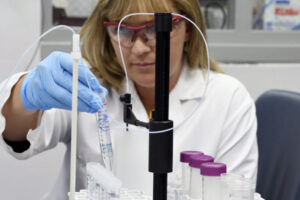 Public health is at the core of what we do. Based on the current data, we do not believe the spill on the Ohio River in northeast Ohio poses a risk to the quality of our drinking water. Your water is safe to drink.
Public health is at the core of what we do. Based on the current data, we do not believe the spill on the Ohio River in northeast Ohio poses a risk to the quality of our drinking water. Your water is safe to drink.
The spill happened after a train derailed on February 3 in East Palestine, Ohio, near the Pennsylvania border. Some of the train cars were carrying chemicals, and low levels of butyl acrylate reached the Ohio River through a small tributary. This chemical is used to produce plastics and resins. The spill happened hundreds of miles from Louisville, but we’re part of a network of water utilities that constantly monitor the Ohio River and the tributaries that feed into the river. That means we knew about the spill soon after it happened and our scientists got to work, looking at how we’d detect the chemical and how we’d handle it in our treatment process.
Over the past few days, our scientists have looked at the size and location of the spill and calculated the travel time of the spill plume to Louisville. This is an advantage of the Ohio River, its size helps with diluting a spill, making it easier to treat. We’re also looking at how we treat the spill if the plume reaches Louisville. We know that trace amounts of this chemical can impart minor odors to the water, but through conventional treatment and the use of powdered activated carbon, we can minimize any taste and odor concerns.
 Every day, we work to protect the safety of your drinking water. Louisville Water operates an EPA-certified laboratory, and our scientists do an average of 200 tests daily on our drinking water. We’re also part of a partnership that includes the drinking water utilities that rely on the Ohio River as well as the Ohio River Valley Water Sanitation Commission (ORSANCO) and state and federal regulatory partners. ORSANCO has a detection system that is located along the entire 981 miles of the Ohio River where utilities and industry use sophisticated instruments to analyze for chemicals that may spill into the river.
Every day, we work to protect the safety of your drinking water. Louisville Water operates an EPA-certified laboratory, and our scientists do an average of 200 tests daily on our drinking water. We’re also part of a partnership that includes the drinking water utilities that rely on the Ohio River as well as the Ohio River Valley Water Sanitation Commission (ORSANCO) and state and federal regulatory partners. ORSANCO has a detection system that is located along the entire 981 miles of the Ohio River where utilities and industry use sophisticated instruments to analyze for chemicals that may spill into the river.
We will continue to monitor and update our response strategy as we learn more.

